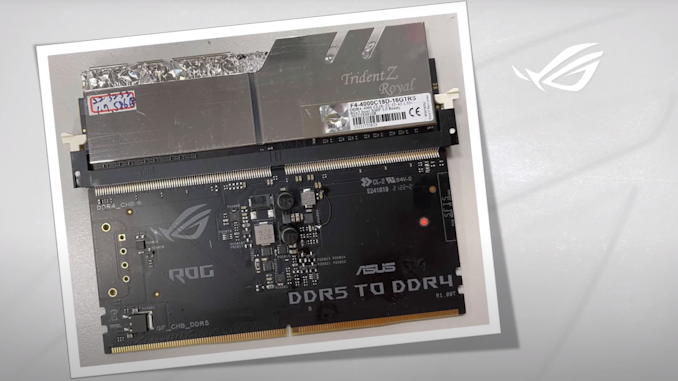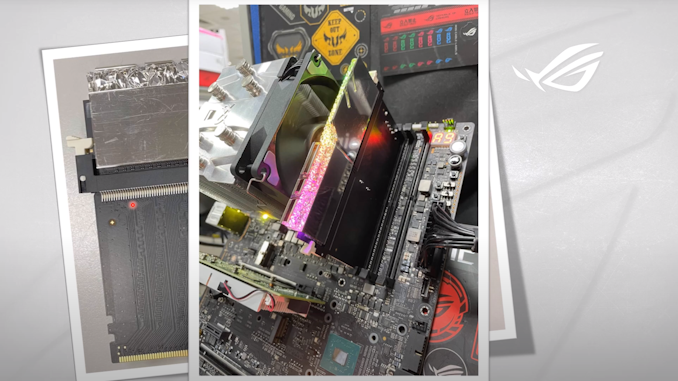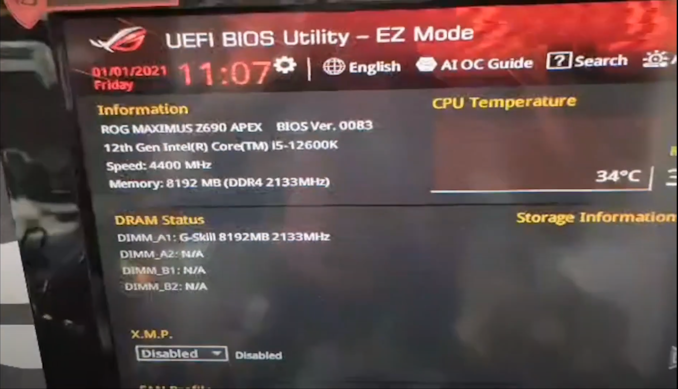ASUS Demonstrates DDR5 to DDR4 Converter Card
by Dr. Ian Cutress on December 30, 2021 2:01 PM EST
One of the key issues with purchasing a modern Alder Lake system today is the cost of the memory, especially when an enthusiast wants to use DDR5. Due to component shortages, particularly the power management controllers that each DDR5 module needs, costs of DDR5 are quickly rising, with some scalpers looking for $1000+ for basic memory kits. The solution to this has been to recommend that users look to pair Alder Lake with DDR4 memory, which although it isn’t the latest, is the more cost effective scenario. The downside to this solution is that the user has a DDR4-only motherboard, and not the next generation DDR5. That might become a solved issue soon enough, however.
In a preview video on YouTube posted today by Bing, who I believe is an ASUS ROG employee, the company has been working on a solution to allow users that buy ASUS Z690 motherboards built on DDR5, to run DDR4 in them. Because Intel limited the platform to either DDR5 or DDR4 per motherboard, there’s no way to run both, until now. In the video, Bing describes the new add-in card they’ve been prototyping.
The use case is fairly simple – have a DDR5 board like the ROG Apex, put the carrier card in a memory slot, and place the qualified DDR4 in the top.
Obviously, the situation here is more complex than simply using this carrier card. DDR5 and DDR4 are more than simply a notch difference between them – DDR4 is a single 64-bit memory channel per module, while DDR5 is dual 32-bit channel per module. The key issue is that DDR5 does power management per module, where DDR4 relies on power management on the motherboard, so that has to be taken into consideration. Also, adding in a carrier card extends memory traces, which could degrade the quality of the signal.
What ASUS does here is use a special BIOS revision to allow the ROG Apex DDR5 to run in DDR4 mode. This means that the traces to the memory slots, although laid out for DDR5 operation, are switched into DDR4 mode. Then, on the carrier card, this takes the 5V power signal and runs it through the equivalent of motherboard power management, and controls the data lines to maintain integrity for signal, latency, power, etc.
Bing explains in the video that this is still very much a prototype. It looks like they’re focusing to get it to work on one motherboard with one memory kit first, before optimizing it. Bing states that the carrier card is very tall, and there is room for optimization to make it smaller in the future before ASUS might offer it as a retail product. Also a wider range of validation is likely needed as well.
The video goes to show with a single DDR4 module in the carrier card the system running at DDR4-4400 with a Core i5-12600K. To confirm DDR5 still works, the system is shown running dual modules of DDR5-4400, at least to the BIOS screen. If these modules come to market, they are still in early prototypes, and ASUS will likely judge feasibility and demand for them for pricing.
Source: YouTube (in Mandarin)













31 Comments
View All Comments
Kunsh - Thursday, December 30, 2021 - link
Try to design 2xDDR4 modules to single DDR5 slot .. that will be fun.kpb321 - Thursday, December 30, 2021 - link
Since this is still in development I'm not sure it will ever see the light of day. It might make sense right now as a way to get a DDR5 board now and use it with DDR4 for a bit until DDR5 prices come down but that is going to be a pretty small window. You are obviously going to have some costs for the adapters and the price differential needs to be noticeably more than that to justify going this route as the adapters will just be a sunk cost once you upgrade to DDR5 most likely. Limited support for motherboards and price differential presumably won't justify using them by the time you upgrade so pretty much no chance to sell them for any meaningful amount. When you factor that in it might be cheaper to just buy a DDR4 MB now and a new DDR5 MB and DDR5 memory when prices come down. Especially if their is a premium for the DDR5 MBs right now too.It might have a window where it makes some sense but it isn't going to be a long one really so it needs to be out ASAP to actually be useful.
DigitalFreak - Friday, December 31, 2021 - link
By the time this thing comes out, either the DDR5 shortage will be over, or it will be ridiculously expensive.COtech - Friday, December 31, 2021 - link
If they can build this into an adapter I'm sure they can build it into their motherboards.I can see this as a proof of concept quick mash-up.
mode_13h - Sunday, January 2, 2022 - link
That would burn valuable motherboard real estate. I think keeping it as an adapter is the better option. That doesn't compromise anything for those who want to run DDR5.Lord of the Bored - Monday, January 3, 2022 - link
They can, easily. The problem is Intel WON'T ALLOW IT, because options are confusing and empty memory slots look ugly.This is what happens when someone takes total control of the platform. You wouldn't have this issue with a SIS chipset.
back2future - Saturday, January 1, 2022 - link
It would be an interesting tool for comparing DDR4 and DDR5 in parallel configuration setups.A lot of items to ask about, with comparing
unhuman - Monday, January 3, 2022 - link
BITD, I used Simmverter to convert 30 pin RAM to 72 pin... Took 4 modules and combined them to 1. The ones I had were not reliable, at all...casteve - Monday, January 3, 2022 - link
The large increase in trace length plus the added connector capacitance will have a big impact on max memory frequency and min CL. Best case scenario is for people that have existing DDR4 RAM they can pop into a new "DDR5" mobo with these adapters. Then, when DDR5 prices become reasonable, buy that.back2future - Monday, January 3, 2022 - link
might result into a 0.1-0.2 nano seconds for 2-3 inch increase for trace length (with suggested values for Er~4 (2.7-3.5 materials for upto 100GHz) for pcb dielectric constant); critical if logic's rise time is lower than trace length delay, increased attenuation?https://www.zuken.com/en/blog/how-to-calculate-tra...
https://www.protoexpress.com/blog/ddr4-vs-ddr5-the...